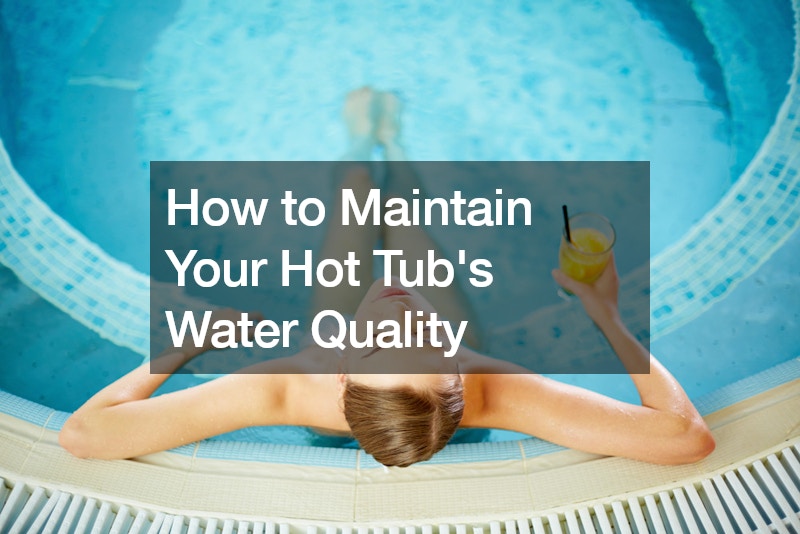Maintaining the quality of your hot tub’s water is essential not only for ensuring a pleasant and hygienic bathing experience but also for extending the lifespan of your hot tub. By regularly checking and adjusting the balance of your water, you can avoid common problems such as murky water, skin irritation, and damage to the tub components. Here, we outline the best practices for maintaining optimal water quality, focusing on simplicity and minimal chemical use.
Understanding the Basics of Hot Tub Chemicals
Hot tub maintenance primarily revolves around managing the water chemistry. This includes the concentration of sanitizers like chlorine or bromine, as well as the pH, alkalinity, and calcium hardness of the water.
Effective water treatment ensures the elimination of harmful bacteria and prevents the build-up of minerals and other substances that can cloud the water and harm the tub.
Essential Water Maintenance Steps
1. Regular Testing:
Begin by regularly testing your hot tub water with test strips, which are readily available and easy to use. While high-end test strips can provide more precise readings, typical test strips are sufficient for keeping an eye on the crucial metrics: alkalinity, pH, and sanitizer levels.
2. Managing Alkalinity and pH:
Alkalinity is the foundation of good water balance. It stabilizes the pH, which in turn can influence how effectively sanitizers work. To maintain water quality, first adjust the alkalinity to the upper end of the acceptable range (around 150 parts per million (ppm) is ideal). This can typically be achieved by adding an alkalinity increaser according to the product instructions, usually about a capful at a time, until the desired level is reached.
After securing a stable alkalinity, check the pH. The ideal pH range is between 7.2 and 7.8. Adjusting the alkalinity often raises the pH as well, so you might need to add a pH reducer to bring it into the optimal range. Remember, each addition should be followed by circulating the water for a few minutes to mix the chemicals thoroughly.
3. Calcium Hardness:
Calcium hardness is crucial to prevent the water from becoming corrosive, which could damage the hot tub’s components. The ideal calcium hardness level is around 150 ppm. This level is typically set when you first fill the tub and can be maintained with minimal adjustments unless you significantly dilute the tub with fresh water.
4. Sanitization:
Sanitizers like chlorine or bromine are vital in keeping your hot tub water clear and free of harmful microorganisms. The concentration needed can vary, typically between 2-5 ppm, depending on the use frequency and the presence of other support systems like ozonators or UV light systems. For minimal sanitizer use, maintaining a level closer to 2 ppm can often suffice, particularly if complemented by a secondary system.
Adding a natural enzyme product can further reduce the need for high sanitizer levels. Enzymes help break down body oils, lotions, and other organic materials that sanitizers alone might not effectively remove. This not only clarifies the water but also reduces the formation of chloramines, which are responsible for the harsh chlorine smell and can cause irritation.
5. Shock Treatment:
Regular shock treatments help to break down organic contaminants and refresh the sanitizer effectiveness. Shocking the hot tub involves adding a large dose of oxidizing chemicals which break down chloramines and other contaminants. This is typically done weekly or after heavy use. After shocking, leave the hot tub cover open for 20-30 minutes to allow gases to escape.
Tips for Easier Maintenance
Routine Checks: Establish a routine to test and adjust your water chemistry weekly. Keeping a log can help you predict the adjustments needed based on previous observations.
Keep It Covered: Always cover your hot tub when not in use to keep out debris and reduce the evaporation of chemicals.
Clean Filters Regularly: Clean the hot tub filters regularly to ensure efficient circulation and filtration. Aside from maintaining water clarity, this reduces strain on your hot tub’s pump and heater.
Annual Deep Clean: Consider an annual deep clean where you drain and thoroughly clean the tub, inspect all elements, and start fresh. This can help tackle any build-up that regular maintenance doesn’t address.
Maintaining your hot tub’s water quality does not have to be overly complicated or chemical-intensive. By focusing on the basics of water chemistry and using hot tub chemicals wisely, you can enjoy a clean and safe soaking experience with minimal effort. Remember, consistent maintenance is the key to keeping your hot tub inviting, relaxing, and ready for use at any time.
.


